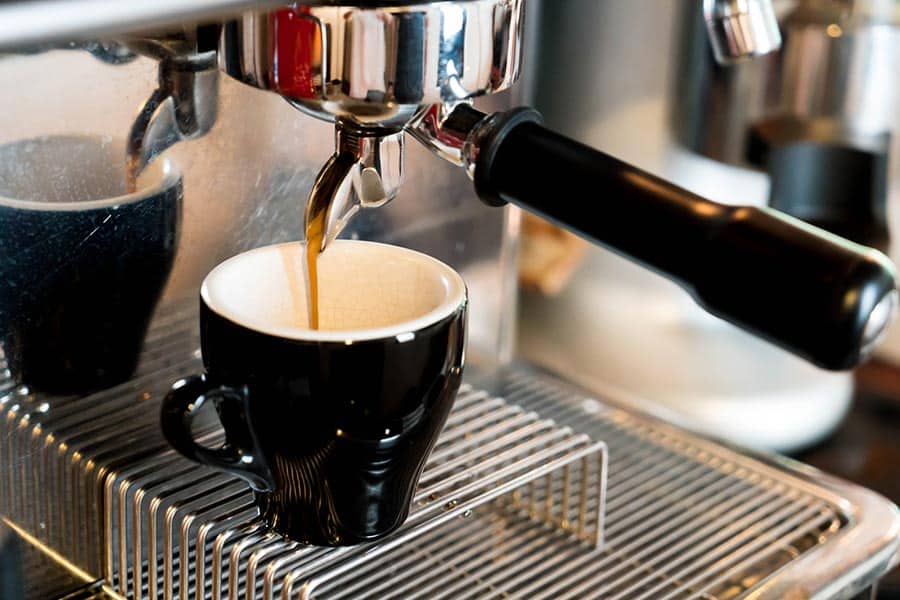How to Make a Cappuccino with an Espresso Machine

Craving for a cappuccino? You don’t have to go out on a coffee run. I’m going to show you how to make a cappuccino with an espresso machine at home.
Anyone can do it. It doesn’t even matter if you have never brewed coffee before. Forget about the guides you may have come across that made this look like rocket science or a frustrating process. The steps are easy to follow, and I have simplified them to your understanding.
Before I walk you through them, it would be best if you first knew and understood the drink you are about to make.
What Is a Cappuccino?
A cappuccino is a coffee beverage that combines steamed milk and milk foam with real espresso. It’s rich in flavor and very bold. Milk adds to the sweetness, while foam gives it that cherished smooth mouthfeel and also serves as an insulator, keeping the drink hot and fresh for a longer period.
Cappuccino has a long and rich history that dates back to the 1900s. Even though it started in Italy (“cappuccino” is an Italian word), it’s believed the Germans adapted this beverage. It did not gain popularity until after the Second World War; however, today, it’s one of the most popular coffee beverages across Europe and the US.
The traditional cappuccino has three ingredients in equal parts, but you are not tied to this ratio. It’s absolutely okay to customize it until you find a flavor profile you love.
A double shot of espresso, for instance, will make a stronger beverage compared to a single shot. More milk and less foam will bring the flavor down to mild without compromising the taste. The resulting beverage is what has come to be known as a “wet” cappuccino.
There’s a “dry” cappuccino as well, and as you might have guessed, it includes more foam, less steamed milk, and a shot of rich espresso. The taste is stronger than that of the traditional cappuccino.
In the past, you could only work with this trio, but a lot has changed since then. You can now flavor your cappuccino further by adding flavored syrups, sweeteners, sugar, or add-ins.
Can you make a cappuccino with an espresso machine? Absolutely yes! Let’s find out how to do it.
How to Make a Cappuccino with an Espresso Machine: Step-by-Step Guide
First, you are going to need real espresso. Strong coffee is another alternative, but it’s not as good as real espresso. You are welcome to try both ways and share the results. For today, we will use espresso.

What You Need
- An espresso machine with a milk steamer
- A handheld milk frother/whisk/blender/French press if your machine lacks a steamer
- Dark roast coffee beans for espresso
- Fresh whole milk (oat milk for vegans)
- Milk jug
- Thermometer
- Cappuccino cups
Step 1: Prepare Espresso

Espresso machines don’t all work the same way. Some are more automated than others and can save you from tasks such as grinding and tamping. Others are more hands-on. I would suggest you first learn and fully understand how your unit works before trying to pull a shot.
If you lack barista-level skills, you are better off with a fully automatic espresso machine where your involvement will be restricted to adding water, coffee grounds, and pressing brew. If you have a semi-automatic or manual espresso machine, the brewing process will be more hands-on.
Follow these steps:
- Add clean water to the reservoir
- Preheat the machine
- Measure and grind the dark roasted coffee beans to a fine size
- Add the coffee grounds to the portafilter and tamp them
- Lock the portafilter into its place
- Press/dial brew
Read this post for more detailed instructions on making espresso.
You can brew a single or double shot, depending on your taste and preference.
Step 2: Steam the Milk

Here comes the lengthiest step, but it can be simple and quick if your espresso maker has a milk steamer. This is how it’s done:
- Wipe the steam wand with a clean piece of cloth and then release steam for 2 seconds to clear any residue inside it
- Fill ⅓ of your jug with fresh whole milk
- Dip half an inch of the steam wand into the milk jug and tilt it at a 15-degree angle
- Activate the aeration and texturing
- When the milk volume increases by half of its size, dip the steam wand tip deeper into the milk to stop the rising
- Let the milk steam until it reaches 120 to140 degrees for a sweeter and richer flavor
- Swirl the milk and then turn off the steam valve
- Wipe the steam wand and release steam again to clear it
Check out our post on how to steam milk for more details.
Don’t panic if your espresso machine lacks a steam wand; there are alternative ways to make steamed milk and foam for a cappuccino at home. You can match the amount of milk to the brewing water or vary it to achieve your preferred outcome.
Regardless of the method, first heat up the milk to around 120 to 140 degrees Fahrenheit.
- Milk frothers – Fill up ⅓ of your jug with the heated milk, hold it at an angle, and then turn on the frother. Move it up and down in the jug until foamy bubbles start to appear. Tap the jug on your counter thereafter to break down the bigger bubbles.
- 2. Whisk – Put the heated milk in a jug or bowl, then whip it up until foam starts to form. Since this method produces slightly bigger bubbles, tap the container on a counter to break them down.
- French Press – Pour heated milk into the French press but don’t fill it up. Put back the lid and pump it up and down. Do this fast to create foam.
- Blender – Both countertop and immersion blenders can froth milk. For the countertop blender, add the milk and switch the speed to medium. Let it run until the milk foams. If you have an immersion blender, first place the milk in a jug or deep pot. Dip the stick blender into it until it’s fully covered by milk then run it at slow speed until foamy bubbles appear.
- Mason Jar / Canning Jar/ Fruit Jar – Add the heated milk to your jar but do not fill it up; leave a bit of room for it to froth. You can wrap it with a dry towel if it’s too hot to be held with bare hands. Secure the lid and then shake it until large bubbles appear. Since this method also produces bigger bubbles, tap the container on a counter to break them down.
Step 3: Add the Foamy Milk to the Espresso
Combine the steamed milk and foam with the espresso. If you are shooting for a traditional cappuccino, use ⅓ steamed milk, ⅓ foam, and ⅓ espresso.
Start pouring from a low height while wiggling the milk jug gently to transfer the foam to the cup so that it can top off your beverage. Tip it further when you get to the foam.

Step 4: Serve
Make your cappuccino drinking experience more authentic by serving your brew in bowl-shaped porcelain cappuccino cups. Go the extra mile of preheating them for a comforting experience.
That’s how to make cappuccino with an espresso machine! I’m sure you will agree that it’s a delicate process requiring some barista-level skills, but the good thing is that it can be done.
Frequently Asked Questions
What makes a good cappuccino?
Cappuccino is famous for its thick foamy layer, but that alone is not enough to make it great. The microfoam should be sweet and airy with a rich structure. You should also be able to recognize the espresso flavor and low acidity.
If the espresso notes are lacking, it could be because you didn’t get the ratio right. You might have used lots of milk, which would dilute the flavor.
A burnt taste is another sign that your cappuccino hasn’t ticked all the boxes. Either you steamed your milk at extremely high temperatures (beyond 140 degrees Fahrenheit) or the espresso shot took longer to be ready.
Even though you can fix the lack of espresso notes or the burnt taste by adding sweeteners or flavored syrups, in the long run, it would be best to get the brewing right before you start using flavor add-ins.
What coffee is best for cappuccino?
Best is relative. Northern Europe, for instance, prefers a sour-sweet flavor. Northern Americans, on the other hand, favor a well-balanced, sharp flavor. It’s therefore difficult for single-origin coffee beans to satisfy the individual tastes and preferences of most coffee users.
That leaves you with blended coffee. The heavier blended flavors are more likely to satisfy most coffee users, but first, check to see that the option you are reaching for is fresh.
Next, make sure it has high acidity as that’s the only way to be sure that the coffee will penetrate the alkalinity of milk. Also, the coffee should be full-bodied, primarily because milk is known to put up a barrier to most coffee flavors.
When it comes to roasts, experiment with the different levels to find out which one satisfies you. Each has unique attributes when it comes to flavor and strength.
Is cappuccino healthier than coffee?
For those without cholesterol problems, this is the drink that will lower your risk of stroke, keep your blood sugar under control (when taken without sweeteners), and aid in digestion.
If you are looking to cut calories, cappuccino may not be the healthiest option because it has more calories than regular coffee since whole milk makes this beverage calorie-rich.
Can I make a cappuccino without an espresso machine?
Espresso is a significant ingredient in the making of cappuccino, and any barista or coffee connoisseur will tell you that nothing makes real espresso except an espresso maker.
Moka pots, French press, and Aeropress make strong coffee, but it lacks the texture, flavor profile, and aroma present in real espresso. So yes, you can make cappuccino with such coffee, but it will not be as rich, flavorful, and bold as one made using real espresso.
Get Your Foam On!
Making cappuccino may look like an uphill battle, but it’s nothing you can’t handle. You can learn and perfect skills such as grinding, tamping, and milk texturing with time.
A fully automatic espresso machine with a milk frother can make everything easier, though. You will have that tasty espresso shot ready in no time without using too much effort or skill. Milk frothing won’t take too much time or brainwork either.
Automatic and semi-automatic models, on the other hand, will require you to be more involved in the cappuccino-making process. Since most of them lack an in-built milk frother, you will also have to figure out other ways to texture your milk. For a beginner, this may sound frustrating, but if you are a coffee connoisseur this is just another exciting brewing experience to explore.
That said, cappuccino is a delicious coffee beverage that every coffee lover deserves to experience. This is your chance to make it from the comfort of your kitchen. All the best!
Owen is a writer and editor at Caffe Streets who considers himself a coffee fanatic. He spends his time researching and testing different coffee beans and brewing methods and sharing what he learns with others.





